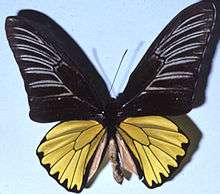Wildlife of the Philippines
.jpg)
| Republic of the Philippines |
|---|
 |
|
The Wildlife of the Philippines includes a significant number of endemic plant and animal species. The country's surrounding waters reportedly[1] have the highest level of marine biodiversity in the world. The Philippines is considered as one of the seventeen megadiverse countries as well as global biodiversity hotspot. In the 2000 Red List of the International Union for the Conservation of Nature and Natural Resources (IUCN), 418 of the country's 52,177 species were listed as threatened.[2]
The Philippines has among the highest rates of discovery in the world with sixteen new species of mammals discovered in the last ten years. Because of this, the rate of endemism for the Philippines has risen and likely will continue to rise.[3]
Birds
There are 612 species of birds found in the Philippines, of which 194 are endemic, 3 have been introduced by humans, and 52 are rare or accidental. There are 67 globally threatened species. These include the rufous hornbill and the critically endangered national bird of the Philippines, the Philippine eagle.
Reptiles and amphibians
There are more than 111 species of Amphibians and 270 species of Reptiles in the Philippines, 80% of the Amphibians are endemic and 70% of the Reptiles of the Philippines are also endemic.[4] It is believed that there are not more than 14 of the 114 total species of snakes in the country are venomous. Several species of reptiles and amphibians remains undiscovered. Unfortunately, several of these species were believed to have disappeared without ever being discovered.[2]
The endemic freshwater crocodile Crocodylus mindorensis is critically endangered and is considered the most threatened crocodilian in the world. In 1982, wild populations were estimated to be only 500-1,000 individuals; by 1995 a mere 100 crocodiles remained living in the wild. The recent discovery of a population of this species in the Sierra Madre mountains of Luzon brings new hope for its conservation. Projects were being made in an effort to save the crocodiles. The Crocodile Rehabilitation, Observance and Conservation (CROC) Project of the Mabuwaya Foundation is active in carrying out such projects.
Other unique and threatened reptiles include Gray's monitor and the Philippine forest turtle. There are two newly discovered species of frugivorous monitor lizard, the Panay monitor lizard from the island of Panay and Northern Sierra Madre forest monitor from north east Luzon, there are only three species of monitor lizards that are specialized frugivores.
Freshwater fish
The Philippines has about 330 freshwater fish,[5] including nine endemic genera and more than 65 endemic species, many of which are confined to single lakes. An example is Sardinella tawilis, a freshwater sardine found only in Taal Lake. Unfortunately, Lake Lanao, in Mindanao, seems to be experiencing the country's most catastrophic extinction event, with nearly all of the lake’s endemic fish species now almost certainly extinct, primarily due to the introduction of tilapia, which is an edible fish, for the expansion of the fishing industry. Other exotic species were also introduced to the lake.[3] 25% of these fishes are endemic.
Insects

About 70 percent of the Philippines’ nearly 21,000 recorded insect species are found only in the country. In addition about one-third of the 915 butterflies found here are endemic to the country, and over 110 of the more than 130 species of tiger beetle are found nowhere else. One of the largest butterflies in the world and the largest in the Philippines, the Magellan birdwing can be found here. The largest moth, the Atlas moth, can be found in the Philippines.[3]
Flora
At the very least, one-third of the more than 9,250 vascular plant species native to the Philippines are endemic. There are, however, no plant families endemic to the country. The families of gingers, begonias, gesneriads, orchids, pandans, palms, and dipterocarps are particularly high in endemic species. For example, two-thirds of the 150 species of palms present in the country are found nowhere else in the world. 700 of the 1,000 species of orchids found in the Philippines are unique to its wildlife.
The broad lowland and hill rain forests of the Philippines, which are mostly gone today, were dominated by at least 45 species of dipterocarps. These massive trees were abundant to up to 1,000 meters above sea level. Other important tree species here include giant figs, which provide food for fruit bats, parrots, and monkeys, and Pterocarpus indicus, which like the dipterocarps, is valued for its timber.
A few species of Rafflesia are found in the Philippines, one of them being Rafflesia philippensis.
See also
- List of extinct animals of the Philippines
- List of threatened species of the Philippines
- List of endemic birds of the Philippines
- List of mammals of the Philippines
- Environmental issues in the Philippines
References
- ↑ Carpenter, K.E. and V.G. Springer. 2005. Environmental Biology of Fishes (2005) 72: 467-480.
- 1 2 "Only in the Philippines". Retrieved 17 March 2015.
- 1 2 3 Conservation International. "Biological diversity in the Philippines". Retrieved 17 March 2015.
- ↑ http://www.nhm.ku.edu/rbrown/Rafes%20PDF%20publications/Brown.et.al.AREES.2013.pdf
- ↑ Nguyen, T.T.T., and S. S. De Silva (2006). Freshwater finfish biodiversity and conservation: an Asian perspective. Biodiversity & Conservation 15(11): 3543-3568